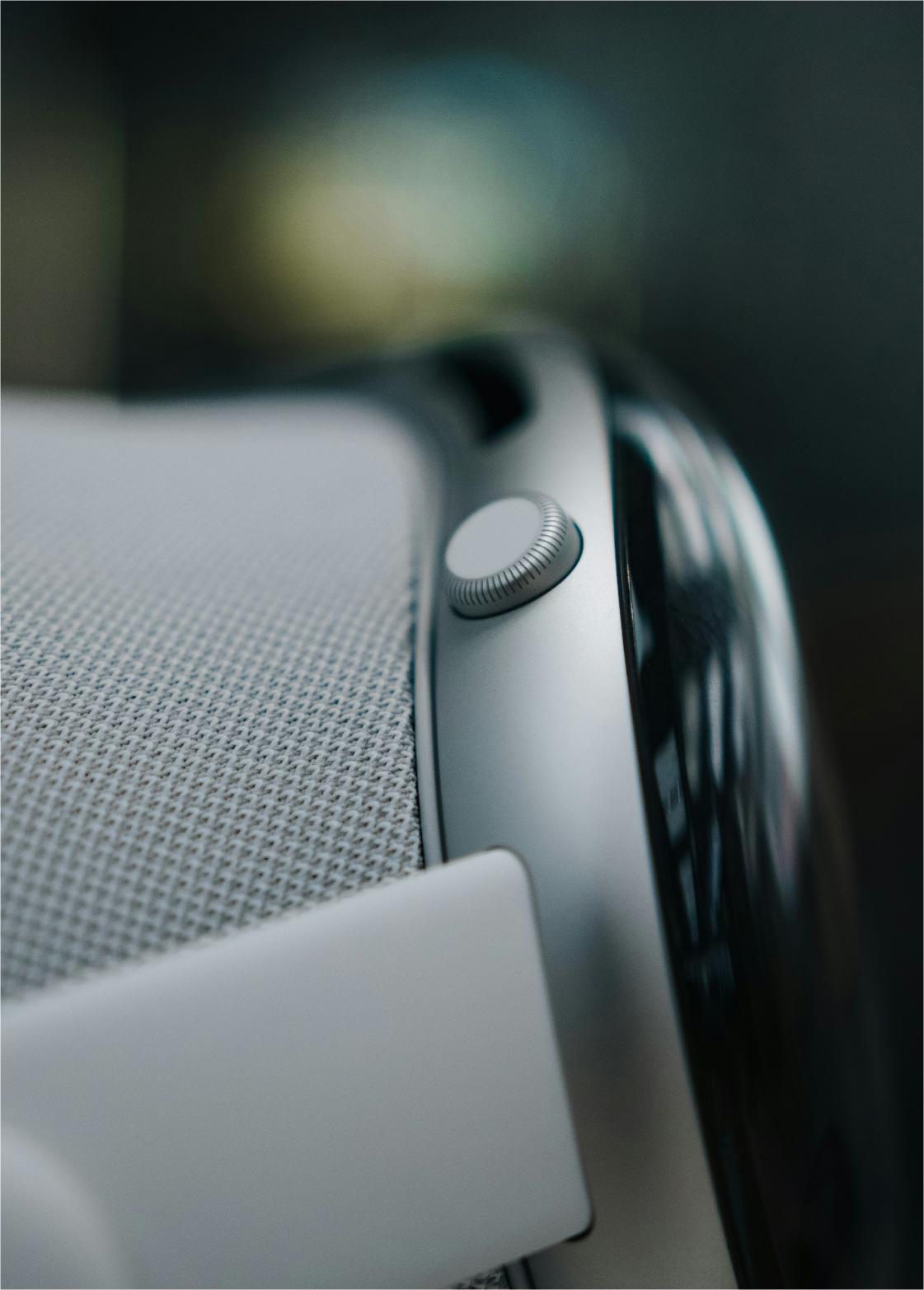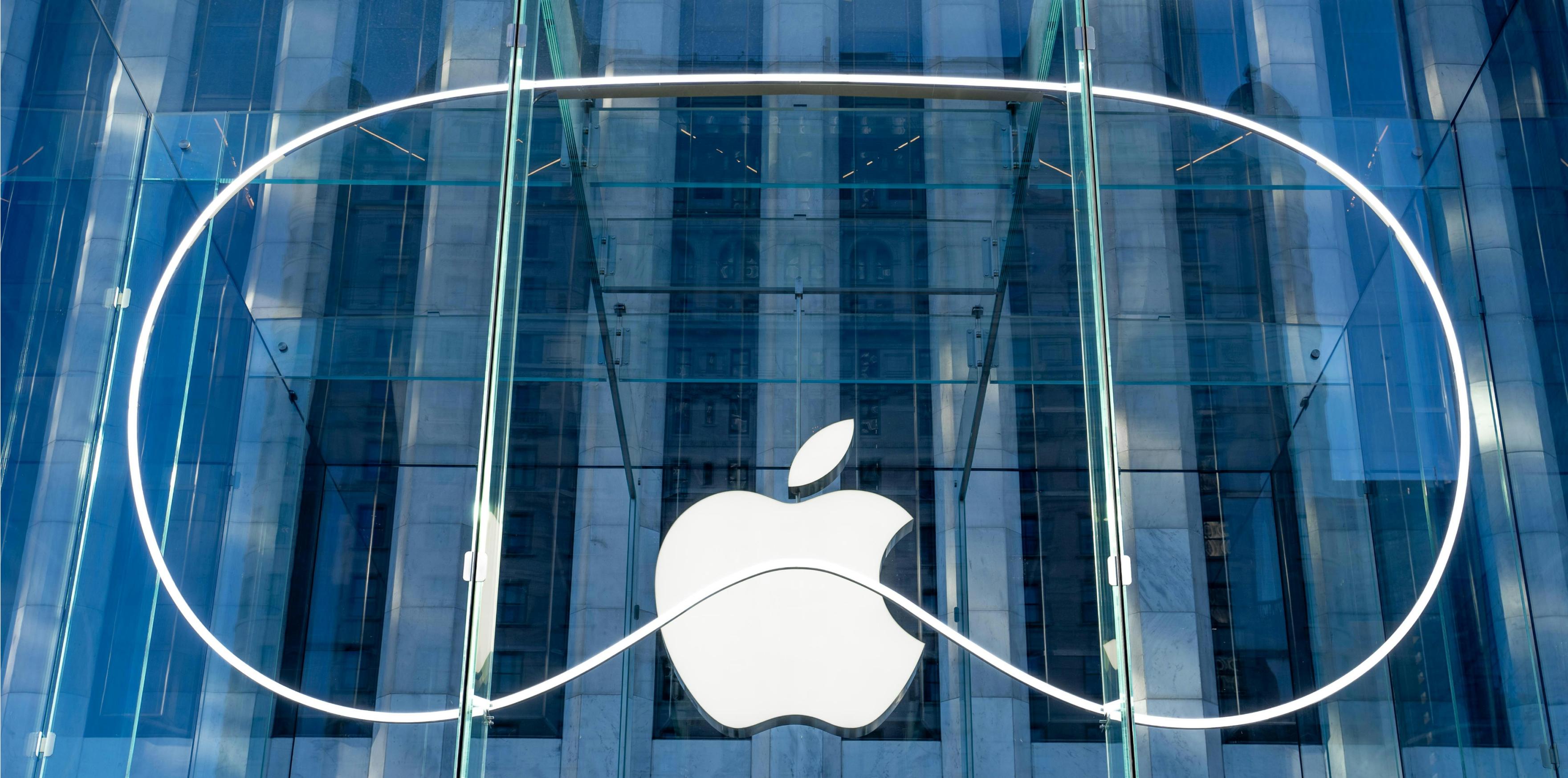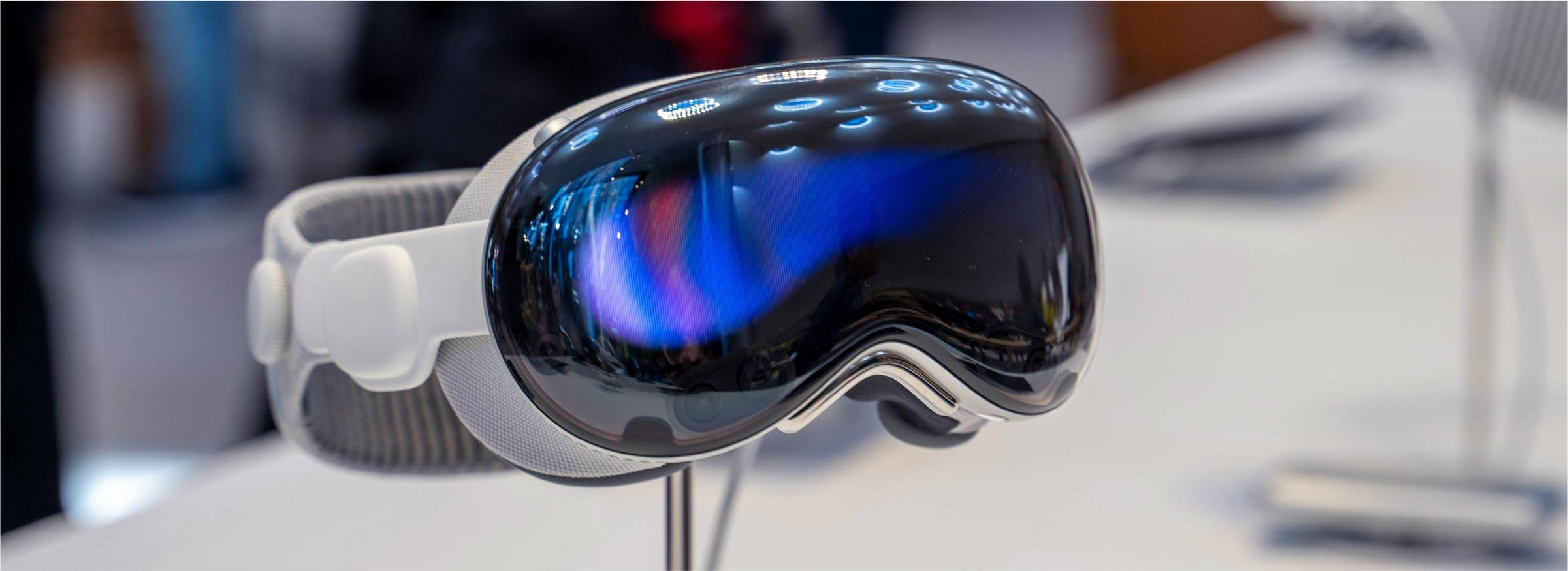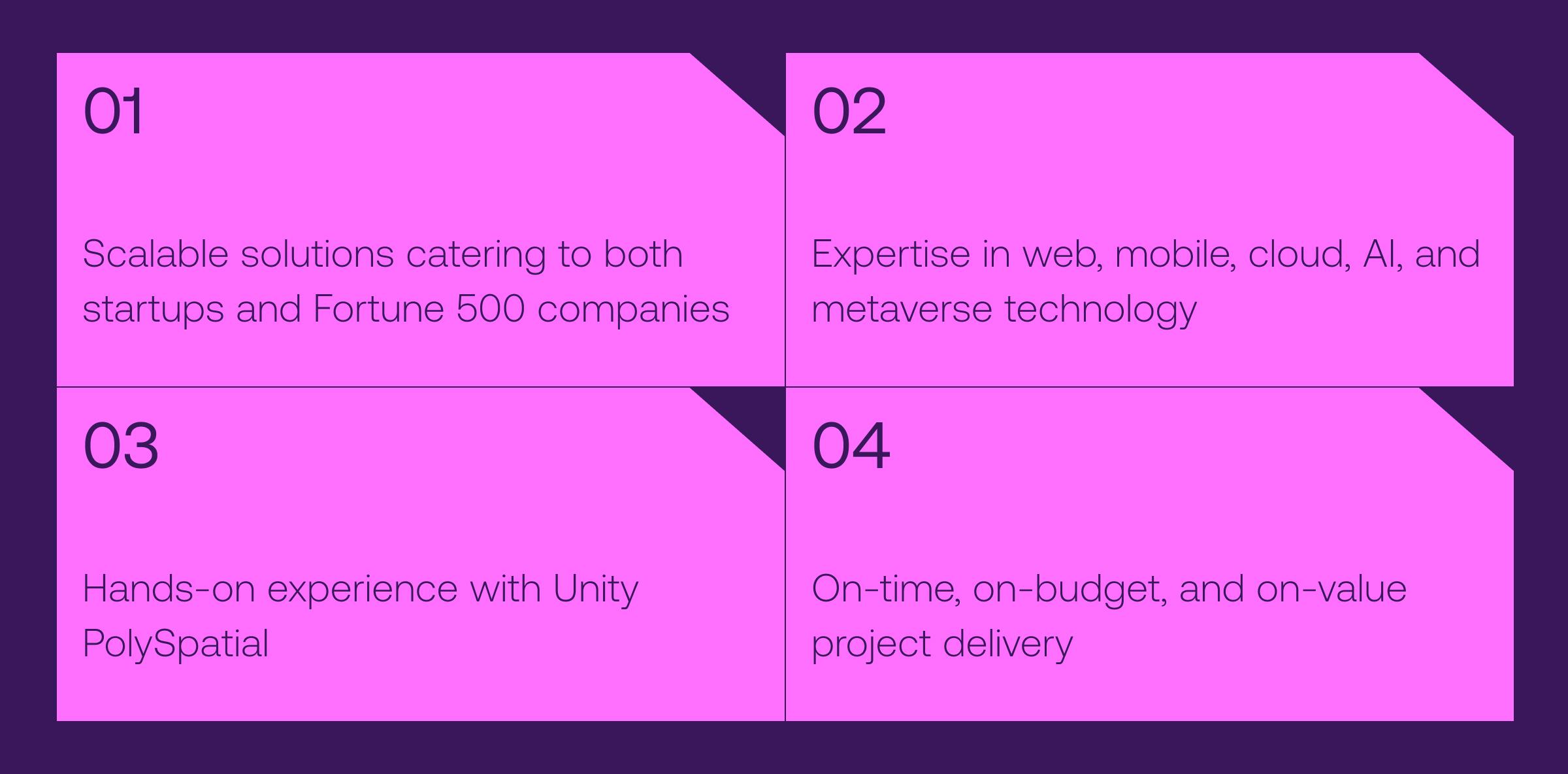
Apple Vision Pro app development guide

Apple Vision Pro is Apple's debut wearable headset that integrates digital content into the physical world. The device represents Apple’s much-anticipated venture into the world of spatial computing and marks a new era of mixed reality development technologies. Apple Vision Pro sports a futuristic ski goggles-like design and state-of-the-art features.

A look under the hood: Apple Vision Pro features breakdown
Eye tracking, hand gestures, and voice commands
Apple headset Vision Pro features an eye and hand tracking control system that allows users to interact with digital environments and apps. The input system also enables you to use natural language commands to control your favorite apps, messages, and notifications.
3D user interface
The Vision Pro headgear seamlessly blends digital content with the real-world environment to create an immersive experience. The system allows users to display and rearrange images and apps in 3D spaces beyond screens.
FaceTime and collaboration features
The Vision Pro’s FaceTime leverages spatial computing and spatial audio to create a virtual meeting space. FaceTime life-sized video tiles make the experience more immersive. You can also use other collaboration apps and simultaneously work with the team on the same documents.
Cinema and gaming experiences
A movie-like experience, fuelled by immersive video and spatial audio, is one of the device's greatest strengths. The headset introduces you to over 250 brand-new spatial games and works with popular game controllers.
App Store and compatibility with other apps
The mixed reality headset offers a brand-new App Store, hosting over 600 apps specifically designed for Apple visionOS. Yet, the actual number of apps accessible on the Vision Pro isn't limited to this, given its compatibility with additional iOS and iPadOS applications.
Customizable environments
Environments is a unique Apple feature that lets you replace your physical surroundings with VR stunts or mixed-reality backdrops. Environments come with their soundscapes that breathe life into immersive photos and videos.
Digital Persona and EyeSight
Vision Pro headset turns you into a hyper-realistic digital avatar that represents you on FaceTime calls and other apps. Excitingly, the device’s EyeSight feature mimics headset users' eyes and helps them remain connected to the world around them.
Apple Vision Pro tech specs: a detailed review
From a technology standpoint, Apple's headset leaps and bounds ahead of the pack in virtual reality solutions. Let’s review the Apple Vision Pro specs and see why it's recognized as something greater than a virtual reality headset.
|
Display and resolution |
Two 1.41-inch high-resolution micro-OLED displays with 23 million pixels combined (exact specs haven’t been revealed yet) |
|
Frame rate |
|
|
Eye tracking technology |
Apple Vision Pro eye tracking system is next-gen, helped by a ring of LEDs and infrared cameras |
|
Optical and audio systems |
|
|
Processing power |
|
|
Authentication system |
Optic ID authentication based on iris recognition |
|
Storage options |
Base storage of 256GB, also available in 512GB and 1TB |
|
Connectivity and compatibility |
|
|
Software |
Runs on visionOS |
|
Accessibility |
Provides support for vision, hearing, mobility, and learning |
How Apple Vision Pro spatial computing takes VR to another level
As Apple’s first spatial computer, the Vision Pro headgear is mainly associated with entertainment and VR gaming. But all fun aside, this device is poised to become a potent instrument with high applicability across industries and domains:
-
Remote collaboration: The device reshapes the world of remote work by enabling immersive video calls that offer unmatched connectivity and collaboration capabilities to remote teams.
-
Architectural design: Vision Pro enables architects to interact with their designs in new ways via 3D virtual setup, streamline visualization development, and create realistic material representation.
-
Retail: From assisted shopping to realistic product views to immersive virtual stores, Apple’s spatial computer completely transforms both the in-store and online buying experience.
-
Education: The headset enables students to modify the scale and level of immersive interaction with educational materials, adjusting the experience to different learning styles.
-
Healthcare: surgery training, vision therapy, telemedicine, medical education — the capabilities of Vision Pro are untapped when it comes to healthcare.
-
Sport: Individuals can receive virtual coaching and simulate various training scenarios by overlaying virtual elements onto real-world environments.
-
Tourism: The headset powers virtual tourism experiences and allows travel agencies to bring their travel marketing into the immersive realm.
Need trusted Apple Vision Pro developers for your next project?
Reach out to Vention and request a quote.
VisionOS for Apple Vision Pro overview
VisionOS, a true beast among operating systems, offers a user experience unlike any Apple OS before it. Specifically designed for spatial computing, it allows developers to craft and innovate a new breed of immersive apps. Here’s what you should know about visionOS:
Frameworks and technologies
VisionOS sits on the frameworks and technologies used for iOS and iPad apps and supports new hardware. Developers can use well-known SwiftUI, UIKit, ARKit, RealityKit, and other frameworks to create visionOS apps that provide powerful, intuitive spatial experiences.
Development environment
With their current knowledge of Xcode IDE, developers can build applications for visionOS. This includes starting from scratch or incorporating visionOS into existing applications, with the ability to iterate on and test UI elements through Xcode Previews and engage with apps in the visionOS simulator.
Reality Composer Pro
The Reality Composer Pro tool facilitates Vision Pro app development by providing an environment for designing and editing 3D content and preparing it for spatial computing apps. Importantly, it’s possible for developers to import 3D compositions from Reality Composer Pro to XCode.
Unity integration
Unity's support for visionOS includes the visionOS Template that lays the foundation for spatial experience development in Unity. Developers can also use all Unity’s core features without modifications, build spatial experiences in RealityKit, and build on visionOS with Unity PolySpatial.
App Store submission and guidelines
The submission process is pretty standard: Make sure your visionOS app meets the specific guidelines of the new App Store and submit the app for review. Existing iOS and iPad apps become automatically available on the Vision Pro App Store.
App icon and motion information
App icons in VisionOS feature a three-dimensional design, showcasing depth between layers and centered imagery. It's mandatory for spatial apps to include motion information, which denotes the app's suitability for users prone to motion sensitivity.

Apple Vision Pro apps: The market is still up for grabs
Over 600 new and shiny apps have recently entered the Vision Pro App Store. Although it might seem like a lot of offerings for a fledgling device, it's still a mere fraction of the extensive App Store catalog of over 4 million apps. (Translation: A huge market opportunity has arrived, waiting to be tapped by global companies.)
The unmatched capabilities of the spatial computing headset are a great fit for app categories like fitness, education, entertainment, and healthcare. And those who will be fast to grasp this opportunity can deliver solutions that pack next-level experiences into immersive applications.
Types of apps cut out for with Vision Pro
The Vision Pro functionality can significantly upgrade your offering if your application is designed to fuse virtual objects with real space through AI, XR, and/or IoT.
Let’s have a quick look at the types of apps that go well with Apple Vision Pro:
-
Productivity apps: Applications for virtual meetings, project management tools, apps for presentations, and planning apps.
-
Fitness and wellness apps: Guided workouts in AR environments, simulations, mindfulness, and yoga apps.
-
Educational and training apps: Apps that provide immersive learning experiences and self-practice sessions, professional training applications.
-
Gaming and entertainment apps: Immersive games and storytelling experiences incorporating spatial audio and visual capabilities.
-
Healthcare and medical apps: Apps for medical training, patient education, or therapeutic uses.
Considerations for Vision Pro app development
-
Target audience research: Gain a deep understanding of your target users' needs and pain points to build a high-value spatial app.
-
Market analysis: Gauge the competition to spot gaps and uniquely position your app in the market.
-
Planning: Define the project scope and plan your resources accordingly to ensure the project's success.
-
Technical chops: Find an experienced app development team well-versed in AR/VR/XR, IoT, and Apple-native technologies.
-
Design and user experience: Design your app to accommodate immersive and spatial experiences and take into account the best design practices for Vision Pro.
-
Performance optimization: Optimize your app’s use of system resources to make sure it delivers a seamless VR experience.
-
Compliance: Make sure your Vision Pro app meets the applicable technical, content, and design criteria.
-
Security and privacy: Your application must comply with Apple’s data privacy policy and adhere to relevant industry-specific regulations.
Unsure where to start with your Apple Vision Pro development project?
Partner with Vention to effortlessly build next-gen immersive experiences.
Accelerate Vision Pro development with Apple Vision Pro SDK
With the extensive suite of developer tools and resources provided by Apple, third-party developers can get a head start on their visionOS development projects. VisionOS SDK helps developers understand Vision Pro's capabilities and provides unique tools such as a visionOS simulator to design all-new experiences.
Here’s how Apple helps developers ease their way into the world of spatial computing:
-
Developer documentation for visionOS: guides and instructions for developing apps.
-
Design kits and human interface guidelines: tools, guidance, and best practices for designing immersive user experiences.
-
Developer labs — located in Cupertino, London, Munich, New York City, Shanghai, Singapore, Sydney, and Tokyo — offer hands-on consultations from Apple engineers.
-
Dev kit program: Eligible developers can apply for the kit to build apps directly on the hardware.
Moreover, each developer framework has built-in dedicated accessibility features, making immersive experiences both groundbreaking and inclusive.
| Apple Vision Pro developer labs | Apple Vision Pro Dev Kit |
|
The Apple Vision Pro Developer Labs are specialized facilities exclusively committed to the support of the new headgear.
As of today, Apple has set up coding labs in eight locations available to visit for the members of the Apple Developer Program and the Apple Developer Enterprise Program.
There, developers can test and improve their visionOS applications, receive professional guidance from Apple experts, and put their apps in for compatibility evaluations. |
Apple Developer Kit is a starter pack for Vision Pro development offered by Apple. The kit is available to approved account holders in the Apple Developer Program.
By applying for the kit, developers can borrow the headset hardware to build and fine-tune their apps. The kit also includes development and design guidance from Apple professionals. |
Core tech stack for Apple Vision Pro app development
Although the exact lineup of tools, technologies, libraries, and frameworks depends on the type of your visionOS app, we’ve rounded up an essential software stack based on Apple’s recommendations.
Here’s how to develop for Vision Pro — the Apple way:
| Technical stack | |
|
Programming language |
Swift |
|
Integrated development environment |
Xcode |
|
Image processing |
Apple Vision Framework Core Image |
|
3D rendering |
RealityKit |
|
Machine learning |
CoreML Create ML |
|
Augmented reality |
ARKit |
|
User interface |
UIKit SwiftUI |
|
Audiovisual |
AVFoundation |
|
Graphics |
Metal SceneKit |
You might also need to employ the following technology solutions to build a Vision Pro app:
-
Data and backend services: Enable you to connect your Vision Pro app to third-party cloud services like AWS to host data storage, databases, and backend logic.
-
Accessibility features: Incorporate assistive technologies into the app to make it accessible to all user groups.
-
TestFlight and App Store Connect: For beta testing and tracking your app’s performance on the App Store.
Hire Apple Vision Pro developers at Vention to make an entry into the spatial app market
Partner with Vention to give your innovative idea a real turn and leverage our extensive 20-year expertise in AR/VR. With over 350+ Apple-related projects in our portfolio, we know how to make your spatial apps user-focused, secure, and truly accessible.
Our workforce, which includes 70% senior developers, has significant experience with the Vision Pro Developer Kit, positioning you to take full advantage of the opportunities within the spatial app marketplace.

Turn your Apple Vision Pro idea into a high-quality app.
You can count on Vention to deliver your spatial app the way you envision it.
Vision Pro app development FAQ
How can I ensure my app is compatible with both visionOS and existing iOS/iPadOS systems?
According to Apple, the headset is backward-compatible with both iPadOS and iOS apps. To ensure compatibility with visionOS, you can submit your Vision Pro app for a compatibility check. Before making a request, validate the performance and core functionality of the app with the visionOS simulator. Additionally, take into account the specs and limitations of each platform to get your app’s design and functionality right.
Can Vision Pro apps support external game controllers, and how is this implemented?
Yes, Vision Pro apps can support external game controllers such as DualShock 4, DualSense, and Xbox, but you should integrate the Game Controller framework into your app to add explicit support.
Where can I find resources and guidelines for Vision Pro app development?
All support documentation is available on Apple’s official developer website. Here, you can learn everything you need to know about visionOS and the headset, including technical documentation, best design practices, developer tools, and more. You can also attend (online or in-person) WWDC sessions to get a first glimpse of new visionOS updates.
What are the best practices for designing user interactions in Vision Pro apps?
According to spatial UI design principles, your app’s UI should consider the depth and scale of visionOS, focus on intuitive interactions, and prioritize ergonomics. Concise labels, clear feedback for user actions, and consistent visual styles will also make spatial interactions more natural and contextually relevant for the end users.
What are Apple's security technologies, and how do I implement them for data protection in my app?
VisionOS has data protection mechanisms similar to iOS, macOS, and iPadOS, including passkeys, Keychain, on-disk encryption, and Apple CryptoKit. Check out Apple’s security framework to see the full list of data security measures to be implemented in Vision Pro apps.





